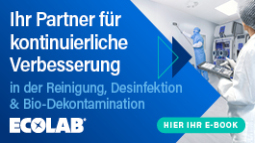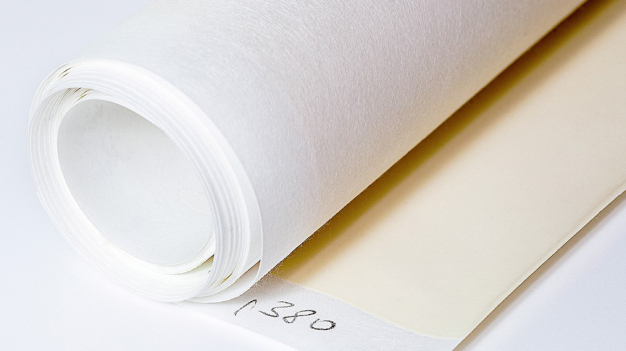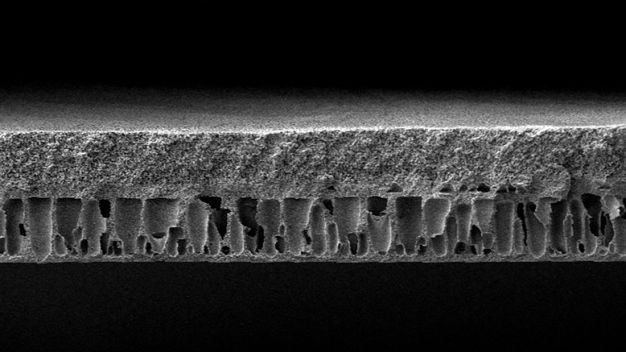- Electronics (wafers, semiconductors, microchips,...)
PFAS-free polymer membranes for semiconductor processing
Due to their stability and resistance to water and grease, PFAS chemicals (short for per- and polyfluoroalkyl substances) are used in a wide range industries, but they are harmful to health and the environment. Membranes containing PFAS are used in many semiconductor manufacturing processes, for example. Researchers from the Fraunhofer Institute for Applied Polymer Research IAP have now developed a sustainable alternative in the form of an innovative, PFAS-free membrane. The chemically stable, highly permeable polymer membrane has a pore diameter of approx. seven nanometers and enables filtration of the smallest particulate contaminants. The membrane can be customized to meet specific needs, which makes it easy to integrate the new process into existing systems.
PFAS chemicals are toxic. They persistently contaminate water and soil and accumulate in humans and animals through food and consumer products. The European Chemicals Agency (ECHA) therefore published a proposal in February 2023 that would ban the production, use and distribution (including the import) of PFAS in the European economic area. The semiconductor industry views the threat of a PFAS ban as a critical issue because the chemicals are used as membranes and housings in filters, as well as in processes such as etching and cleaning. According to numerous manufacturers, there is no viable alternative to the longlasting per- and polyfluoroalkyl chemicals, and banning them would make production of most semiconductor products impossible. However, researchers at Fraunhofer IAP in Potsdam have now successfully developed a PFAS-free membrane for a supplier to the semiconductor industry. This membrane is based on conventional, specifically stabilized polymers, which could replace PFAS membranes. The polymer polyacrylonitrile (PAN) membrane offers high chemical and mechanical stability. It also has an extremely small pore diameter of around seven nanometers. This is necessary to separate particulate impurities from production and to filter and recycle the fluids required for the process, such as acids and solvents. The membrane can be customized to meet specific needs, which makes it easy to integrate the new process into existing systems to manufacture the next generation of chips.
Impurities and contaminants must be avoided
“Chip manufacturing involves numerous process steps such as cutting, cleaning and planarization to apply the structures to the wafer. All of these operations produce particulate contaminants that must be separated out in each process, otherwise they would interfere with the creation of nanometersized structures,” says Dr. Murat Tutus, engineer at Fraunhofer IAP and head of the “Membranes and functional films” department. Murat Tutus and his team have succeeded in creating a chemically and mechanically highly stable membrane made of conventional polymer, which can filter out particles with a pore size of just seven nanometers. For comparison: In medical engineering, filters with a pore size of 220 nanometers are used for sterile filtration. “We were able to use another component patented by us to chemically modify the polymer and stabilize it also for harsh environments,” says the researcher.
The researchers were also tasked with achieving a pore size distribution that deviated only negligibly from seven nanometers. In addition, the membrane should be highly permeable. “The degree of permeability is defined by the number of pores on the surface. The smaller the pores, the lower the permeability. To increase permeability, we therefore had to increase the number of pores in a second step while keeping the pore size constant,” explains Tutus.
Membrane production with REACH-compliant solvents
Since the membrane’s pore size and permeability can be customized to specific needs, it will be easy to adapt it to diverse applications in other industries. As an added benefit, membrane customization means that existing systems can continue to be used and no staff training is required. Dr. Tutus and his team see a great deal of potential for their developments in the pharmaceutical and chemical industries, which also use aggressive solvents. The membrane production itself uses REACH-compliant solvents (Registration, Evaluation, Authorization and Restriction of Chemicals) and low temperatures throughout, making it an overall sustainable process. The membrane is fabricated using a NIPS (non-solvent induced phase separation) process, which also allows researchers to customize the morphology, or pressure stability, of the membrane.
Fraunhofer-Institut für Angewandte Polymerforschung IAP
14476 Potsdam-Golm
Germany










